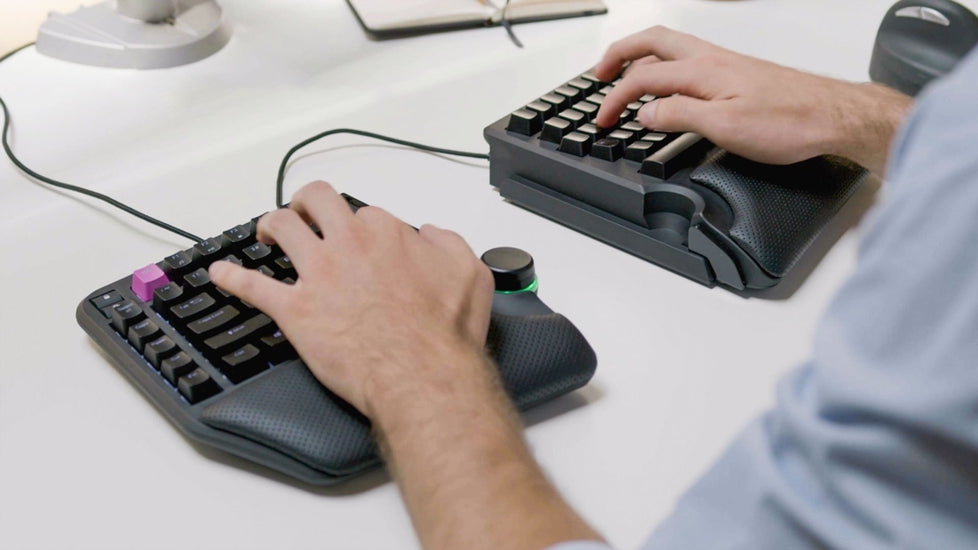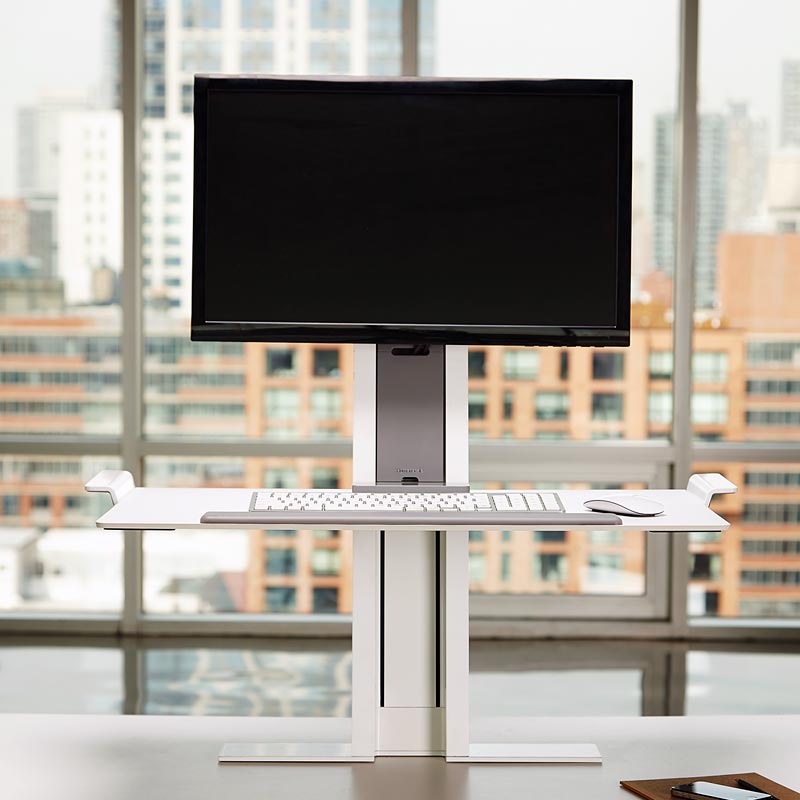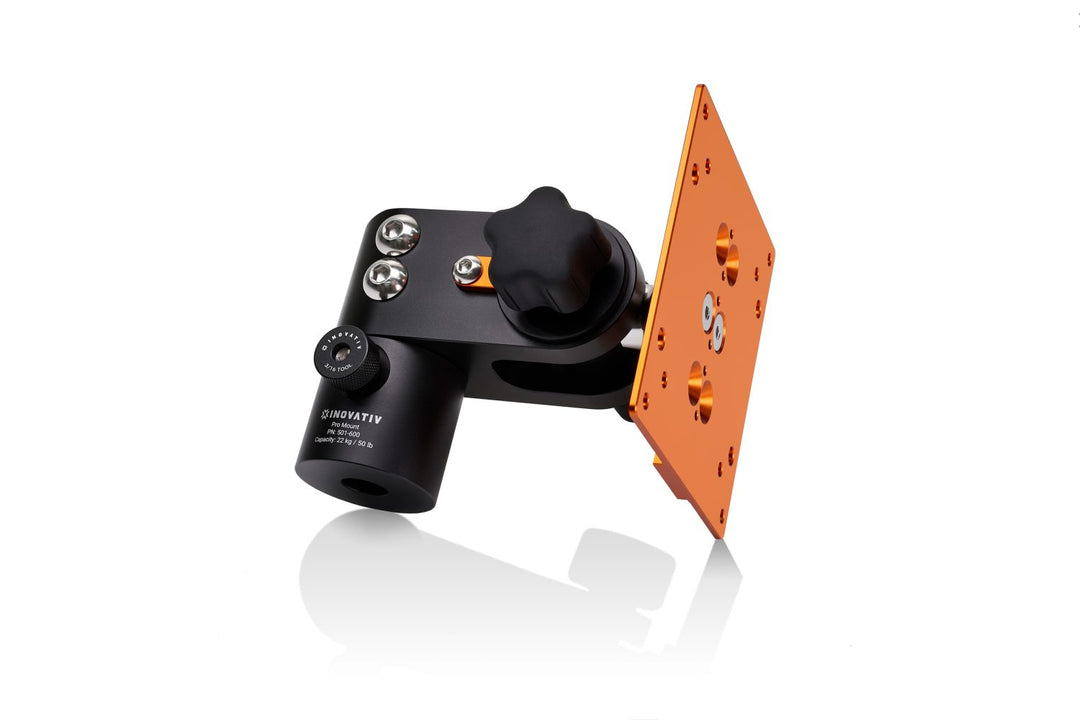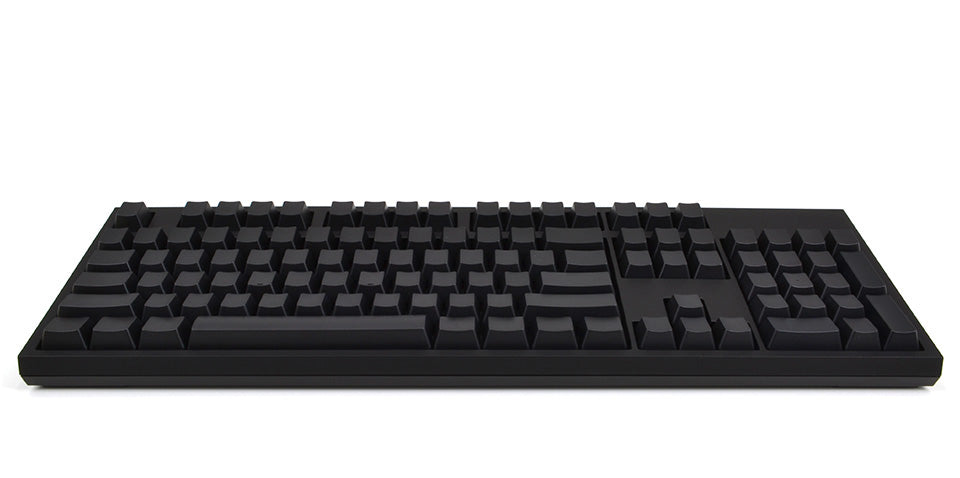Key Takeaways:
- Understanding the VESA standard is essential for selecting the right mount to fit your monitor. The standard defines the hole patterns on the back of a monitor, which determine whether a mount can be used.
- Checking for VESA compatibility can be done using the mount finder tool, or by manually checking the primary criteria for compatibility, including the distance between each hole and the weight and screen size of the display. The VESA standard has three variants.
- VESA specifications include hole patterns and screw sizes, monitor weight and screen size guidelines, and Ergotron's comprehensive line of VESA mounts. The MIS-D interface is the most common for monitors, and Ergotron offers MIS-D-compatible VESA mounts. MIS-E and MIS-F are interfaces for mid-size displays with varied hole patterns and screw sizes.
- Custom interface adapters can be used for non-VESA-compliant monitors. Contacting the monitor manufacturer or Ergotron for an adapter is recommended. Attaching Apple displays to VESA mounts can be done with an adapter bracket or retrofit options provided by Apple. Choosing the right VESA mount ultimately depends on the type of monitor and personal needs.
Understanding the VESA Standard
The VESA Standard is essential for VESA mount compatibility and proper installation. It defines the dimensions, four-hole attachment interface, hole pattern, and torquing forces required for secure monitor mounts. The table below shows VESA hole pattern guidelines for MIS-D, MIS-E, MIS-F, 100, and 75, for screens ranging from 10 to 70 inches, and weights ranging from 10 to 250 lbs.
| VESA Hole Pattern Guidelines | Screen Size (in) | Weight (lbs) |
|---|---|---|
| MIS-D | 10 to 30 | up to 50 |
| MIS-E | 31 to 55 | 50 to 200 |
| MIS-F | Over 55 | Over 200 |
| 100 | N/A | up to 50 |
| 75 | N/A | up to 30 |
Unique details to note are the varied hole patterns that may exist, spacing between holes, and the use of M6 or M8 screws. Custom interface adapters may be needed, particularly for Apple displays like the iMac, which require a retrofit or the use of a VESA interface accessory.
Suggested tips for VESA mounting include using a torque driver for proper screw tightening, using level installation, and avoiding over-tightening screws or using incorrect screws. It is essential to use the appropriate VESA mount standard and follow manufacturer instructions for safe and secure display mounting.
Checking for VESA Compatibility
To ensure that your display is compatible with VESA mounts, it is important to check its VESA compliance. This can be done by looking for the VESA mounting pattern, which is a rectangular hole pattern on the back of the display. Use the VESA mount finder tool or check the display's manual to determine the specific VESA size and mounting screw requirements or you can simply check the manufactures website for VESA compliant mounting.
It's also important to note that not all displays are VESA compliant or have the same VESA mounting pattern. Some C compliant displays may require an adapter or a VESA mounting bracket to be used with certain VESA mounts.
Pro Tip: Make sure to double-check all measurements and requirements before purchasing a VESA mount to ensure proper compatibility.
Using the Mount Finder tool
The VESA Mount Guide provides a Mount Finder tool that helps in identifying a standard VESA mount. This allows for display compatibility, ensuring an appropriate and secure mounting solution.
- Access the VESA Mount Guide website.
- Select the option for 'Using the Mount Finder tool.'
- Enter the brand and model of the display in question.
- Check for any FDMI compatibility information provided by the manufacturer of the display.
- If necessary, check for VESA mounting screws/brackets required for mounting compatibility
It is crucial to note that not all displays have FDMI compatibility information or VESA mounting screws/brackets included. These are typically only found on larger displays or those marketed as being mount compatible.
One user shared that they recently purchased a new display only to discover upon arrival that it did not have a VESA mount. Using the Mount Finder tool, they were able to identify which compatible mounts would work with their device, saving them time and frustration in finding a suitable solution.
Primary criteria for compatibility
To ensure compatibility between your VESA mount and monitor, there are several primary criteria to consider. These include the VESA pattern, size compatibility, weight capacity, and screw hole location.
| Criteria | Details |
|---|---|
| VESA pattern | The distance between the mounting holes on the back of your monitor. Common patterns include 75x75mm and 100x100mm. Ensure your VESA mount supports the same pattern as your monitor. |
| Size compatibility | Make sure your VESA mount can accommodate the size of your monitor. Check the screen diagonal to confirm before purchasing a mount. |
| Weight capacity | Ensure that the weight of your monitor falls within the range specified by the VESA mount's weight capacity. |
| Screw hole location | Confirm that the mounting screws on the VESA mount align with those on the back of your monitor. |
In addition to these primary criteria, there are some unique details you should consider when checking for VESA compatibility with vesa mounting screws. Double-check to make sure everything fits properly before you drill any holes in walls or other surfaces.
For example, one user ended up needing additional spacers for their VESA setup because their monitors had a curve to them that affected the distance between them and where they were mounted.
Three variants of the standard
The VESA standard comes in three different versions, each with their own unique specifications.
| Version | Dimensions (mm) | Screen Weight Limit (kg) |
|---|---|---|
| 75x75 | 75x75 | Up to 7 |
| 100x100 | 100x100 | Up to 10 |
| 200x200 | 200x200 | Up to 40 |
It's important to note that certain monitors and screens are only compatible with specific VESA standards. Be sure to check the mount compatibility before attempting installation.
VESA mounting screws should also be used as specified for safe and secure installation.
True Fact: Using improper VESA mounting screws can cause damage or even harm to the display and surrounding environment. (Source: Dell VESA. )VESA Specifications
VESA Standard Details:
VESA, or Video Electronics Standards Association, is responsible for establishing standards for mounting displays, particularly computer monitors and televisions. The VESA standard specifies certain criteria that must be met by the mount and display. These specifications ensure that the monitor or TV can be attached to a compatible wall or desk mount and provide appropriate viewing angles.
The table below lists the VESA specifications for various display sizes:
| Display Size | VESA Standard |
|---|---|
| Less than 30" | Up to 200x200mm |
| 30" to 50" | Up to 400x400mm |
| 50" to 70" | Up to 600x400mm |
| Greater than 70" | Up to 800x400mm |
It is important to note that manufacturers may have specific VESA patterns for their displays. These patterns may not fit the VESA standard, so it is essential to check the manufacturer's specifications when selecting a mount.
Generally, larger displays require more significant VESA standards to ensure secure mounting and prevent damage to both the display and mount during installation.
According to a report by Grand View Research, the global market size for VESA compliant display mounts was valued at $2.05 billion in 2018 and is expected to continue growing due to an increase in enterprise spending on desktop setups.
Hole patterns and screw sizes
A significant aspect when it comes to VESA mounting is the arrangement of the screw holes and screw sizes. The hole patterns and screw sizes may differ depending on the size of the device being mounted. Therefore, understanding these specifications is crucial to mount devices accurately.
The following table provides an overview of typical VESA hole patterns and their corresponding screw sizes:
| Hole Pattern | Screw Size |
|---|---|
| 75×75 mm | M4 |
| 100×100 mm | M4 or M5 |
| 200×100 mm | M4 or M5 |
| 200×200 mm | M6 |
Unique details to note are that most VESA mounts come with screws included, but if not, it's essential to use screws with proper thread pitch and width. Stripping a screw can compromise the integrity of the mount, making it essential always to use appropriate tools when installing.
In a similar tone, to explain further, we heard from a consumer who used incorrect screws while mounting their device resulting in it dropping and damaging the wall. Therefore proper equipment must be utilized at all times and checked before mounting any display device.
Monitor weight and screen size guidelines
When considering the appropriate VESA standard for your monitor, it is important to take note of the weight and screen size guidelines. The VESA standard ensures manufacturers follow a uniform design for mounting monitors on walls or brackets. This reduces compatibility issues between different brands and variations.
The Monitor Weight and Screen Size Guidelines can be summarized in the below table:
| Monitor Size (inches) | Maximum Weight (lbs) |
|---|---|
| 19 - 22 | <15 |
| 23 - 25 | <20 |
| 26 - 32 | <35 |
| >32 | dependent on individual model |
It is essential to understand that these guidelines help reduce the risk of damage to both the monitor and mounting structure. Following such measures typically means less maintenance after installation, leading to a more robust, long-lasting setup.
It's worth noting that even if your monitor falls within the above criteria, you should check how compatible it is with your specific mount or bracket. Manufacturers like to specify their own guidelines as different product models' dimensions can impact the VESA compatibility.
Along with checking VESA standards and examining your monitor's specifications, you may want to test out various viewing angles before finally settling on a location. Ensure there are no obstructions blocking clear sightlines from all vantage points in your room. Doing so helps ensure an optimal viewing experience while also safeguarding against unwanted collisions and damage.
Ergotrons comprehensive line of VESA mounts
Ergotron offers an all-inclusive range of VESA standard compliant mounts to secure displays of various sizes and weights. Their line of VESA compatible mounts includes fixed, tilting, multi-monitor, wall-mounted, and desk-mounted options to fit any workplace or personal standards.
The table below illustrates the different Ergotron VESA mount product types with their specifications:
| Product Type | Max Weight Capacity | Tilt Range |
|---|---|---|
| Fixed | 30 lbs | N/A |
| Tilting | 25 lbs | -5° to +15° |
| Monitor | 24" | N/A |
| Wall-mount | 40 lbs | N/A |
| Desk-mount | 30 lbs per arm | -75° to +75° |
Moreover, Ergotron's six-point adjustment system ensures ergonomic comfort while optimizing productivity. Each mount is engineered with durability and reliability in mind and is built with high-quality materials.
Pro Tip: Before purchasing a VESA mount for your display, ensure that it is compatible with both the monitor and the mounting surface. Read product descriptions carefully and take accurate measurements before placing the order.
VESA MIS-D
Paragraph 1 - VESA mounting interface standard (MIS) is a specification for monitor mounting that defines the location of the mounting points and the type of fasteners used for attaching monitors to mounts. MIS-D is a VESA-compliant 100mm square mount with four screws arranged in a rectangle.
Paragraph 2 - The following table presents the VESA MIS-D standard in detail:
| VESA Standard | Mounting Interface | Horizontal Distance | Vertical Distance | Screw Type |
|---|---|---|---|---|
| MIS-D | 100x100 | 75 | 75 | M4 x 10mm |
Paragraph 3 - The VESA MIS-D standard is popularly used in mounting computer monitors. What sets it apart is its 100mm square mount with four screws arranged in a rectangle that ensures a secure and sturdy mount. The mount is suitable for monitors with a weight of up to 30 kg, making it ideal for larger monitors and displays.
Paragraph 4 - To ensure a successful VESA MIS-D mount installation, it is recommended to follow the manufacturer's instructions strictly. Ensure that you have the appropriate tools for the job and take precautions while handling the monitor and mount. Additionally, consider the height and viewing distance when mounting your monitor to avoid any ergonomic issues.
Most common interface for monitors
The display interface in use for most monitors nowadays is prevalent. It is the VESA standard, used to ensure compliance with a wide range of setups. The VESA Mis-D mounting interface standard has established common dimensions and mounting patterns for LCD/TFT monitors. The standard enables easy attachment of compatible devices to a variety of suspension or support systems, such as wall mounts and desk-arm assemblies. Compatible devices are now located all over the world, giving users flexibility when choosing mounts while maintaining safety and stability.
The VESA Mis-D series still provides value beyond conventional lifestyles. As producers continue to innovate new ways of designing, screen mountings are adapting alongside technology development opportunities.
As innovations are continually made in Screen Mounting technology, it is essential to look at what influenced their creation in the first place. The stakes are high, making it crucial that designs are safe and efficient. In the 90s when flat-screen televisions were becoming more prevalent and traditional CRT displays were on the way out; there was a need for creating standardized mountings that would be simple enough to assemble and hold large weight-bearing displays contemporary at that time. Consequently, the Video Electronics Standard Association (VESA) - Verband der Elektrotechnik with its 100+ members created standardized connection points on electronic displays.
Ergotrons MIS-D-compatible VESA mounts
The VESA-compatible mounts by Ergotron are designed with the MIS-D specification in mind. These mounts provide a streamlined solution for attaching displays that meet VESA mounting standards to different surfaces. These include articulating arms, desktop stands, and wall mounts.
Ergotron's VESA-mounts have diverse features and functionalities that cater to various needs. Their unique ergonomic designs increase comfort and productivity while reducing workplace energy consumption. These capabilities make them ideal for both home and office use.
Moreover, these mounts are compatible with a wide range of devices ranging from small tablets to giant display screens up to 42 inches in size. Advanced cable management systems help prevent loose cords and wires, keeping workspaces clean.
According to DisplaySpecifications.com, Ergotron's VESA Mounts rank among the best in their category, displaying top-notch quality and reliability at affordable prices.
VESA MIS-E
Paragraph 1: VESA Mounting Interface Standard Extension (MIS-E) is a standard for attaching flat-panel monitors to mounts, brackets, and arms. It specifies a hole pattern on the back of the display and an interface bracket that allows the display to be mounted quickly and easily.
Paragraph 2:
| Feature | Specifications |
|---|---|
| Hole Pattern | 75 mm x 75 mm |
| 100 mm x 100 mm | |
| Bracket size | 152 mm x 152 mm |
| 200 mm x 200 mm | |
| 400 mm x 400 mm |
Paragraph 3: Unlike VESA MIS-D, which can support heavier displays, VESA MIS-E is mainly for smaller displays that weigh less than 30 pounds. It is essential to ensure the mount or arm selected is compatible with the VESA MIS-E standard.
Paragraph 4: Don't miss out on the convenience and flexibility that comes with using a VESA MIS-E standard mount. Ensure your display is secure and mounted correctly by following the VESA guidelines. Upgrade your workspace experience now.
Interface for mid-size displays
As the name suggests, VESA MIS-E is a universal mounting interface for mid-size displays, making it easy to mount multiple brands of displays onto compatible mounts. This standard ensures that the display has VESA-compatible screw holes in the back, which allows it to be securely mounted on a wall or desk mount.
The VESA MIS-E standard includes measurements for the diagonal distance between mounting holes, as well as specifications for maximum weight capacity and screw hole pattern. This universal interface is widely used by manufacturers in the industry to ensure compatibility with various sizes of mid-size displays.
It's important to note that not all displays are compatible with VESA mounting patterns, so it's essential to check before purchasing a monitor. Using this universal mounting interface makes your workspace more organized and tidy by freeing up desk space.
For best results when utilizing this standard, choose mounts that have been designed with compatible dimensions, weight capacity and screw patterns. Furthermore, make sure you follow proper installation procedures by checking manufacturer instructions and avoiding over-tightening screws. By following these suggestions can help prolong display lifespan.
Adapter kit for converting MIS-D mounting plate
An adapter kit is an essential component for converting a MIS-D mounting plate to VESA. It enables the display to be attached to a monitor arm or stand that adheres to VESA standards.
Here is a 4-Step Guide to using an 'Adapter kit for converting MIS-D mounting plate':
- Ensure all components - screws, nuts, and washers included in the adapter kit are available.
- Attach the screws onto the four corners of the adapter plate with the aid of washers and nuts.
- Place the conversion plate on top of your display's existing mount location and screw it down firmly with all screws utilizing washers appropriately.
- Your VESA compatible mount can now be screwed onto the new conversion plate using common VESA holes. Ensure that you tighten accordingly.
It is important to note that some adapters require specialty conversion plates. Therefore ensure that your conversion plate is compatible with your model before purchase.
Pro Tip: Always refer to installation instructions from both manufacturers before assembling hardware.
Ergotrons MIS-E VESA mounts
Ergonomically designed interface adapters are in high demand, and the Ergotron MIS-E VESA Mounts fulfill that demand perfectly.
- Ergotron offers a wide variety of MIS-E VESA mounts to fit any display or device requirement.
- These mounts provide ease of adjustability, allowing you to adjust your screen's height and angle for maximum comfort.
- The durable material made from heavy-duty metals allows for extended use without damage.
- The cable management system ensures a clean and clutter-free workspace, keeping your viewing experience distraction-free.
- The quick-release mechanism guarantees an attachment and detachment process without any tools, making it ideal for those who have on-the-go requirements.
For those who value quality with ergonomic design and robust capabilities, the Ergotron MIS-E VESA Mounts won't disappoint.
Innovations never seize in the world of interfaces, especially when considering custom interface adapters like VESA mounts. Before making a purchase decision for a new mount, it's important to understand what else is available in the market to make an informed choice.
A friend was looking for a solution to ergonomically optimize their workspace but had trouble finding one within budget constraints until they came across the Ergotron MIS-E VESA Mounts. They were beyond impressed with the mount's quality and features and appreciated how budget-friendly it was compared to other options available in the market - proving its value greatly outweighed its cost.
VESA MIS-F
Paragraph 1 - The VESA Mounting Interface Standard (MIS) forms the foundation on how monitors can be mounted. The VESA MIS-F standard refers to the spacing of four mounting holes on the back of a display screen.
Paragraph 2 - The VESA MIS-F standard has a hole pattern of 100mm x 100mm, with four holes that are M4 threaded at the corners of a square. This allows for easy and secure installation of the display on a standard VESA-compatible mount. The table below shows the dimensions of the VESA MIS-F standard.
| VESA MIS-F Standard Dimensions | ||||
|---|---|---|---|---|
| Dimensions (mm) | Size A | Size B | Size C | Size D |
| Hole Pattern | 100 | 100 | 100 | 100 |
| a | 199.6 | 199.6 | 200 | 200 |
| b | 199.6 | 199.6 | 200 | 200 |
Paragraph 3 - It is important to note that not all displays are VESA MIS-F compliant. Devices that do not meet the VESA MIS-F standard may require a special mounting solution. Additionally, the VESA MIS-F standard is only one of several VESA MIS standards that exist for different display sizes.
Paragraph 4 - One true fact is that VESA is an international non-profit corporation that develops standards and specifications for the electronics industry. (Source)
Varied hole patterns and screw sizes
The VESA standard introduces diverse hole patterns and screw sizes to ensure optimal compatibility between displays and mounts for most electronic gadgets. These variations encourage a higher degree of customisation, permitting users to find an appropriate fit that best suits their device.
To gain further insight, we have compiled a table below on some of the frequently used VESA hole pattern dimensions (measured in mm).
| Hole Pattern | Screw Size (mm) | Size A (mm) | Size B (mm) |
|---|---|---|---|
| 75x75 | M4 | 75 | 75 |
| 100x100 | M4 | 100 | 100 |
| 200x100 | M4 | 200 | 100 |
| 200x200 | M6 | 200 | 200 |
It's also crucial to take note of the proximity between the mounting holes' centre for various VESA standards. These differences can impact their compatibility with different screen sizes. For instance, while larger screens may need a more extensive gap between screws, smaller sizes may require closer spacing.
When selecting your mount or display bracket, our advice is to consider your gadget's measurements first before using this guide and selecting the right size bracket based on those criteria. Remember that some devices feature different VESA standards than what is commonly found; thus, it will help to cross-check this information in your user manual before buying any mount or bracket.
In summary, knowing how to choose the correct VESA mount is vital when installing displays and televisions in various settings such as homes, offices, or commercial installations. By following these tips carefully while considering factors like the distance between mounting holes and screw sizes/shapes, you'll be able to seamlessly navigate through these mounting practices without issues.
Ergotrons VESA mounts for MIS-F displays
Ergotron's Mounts for MIS-F Displays
Ergotron's VESA mount is a perfect solution to mount your MIS-F displays effortlessly. The mount secures the display in place and helps create an ergonomic workstation.
The following table displays the specifications of Ergotron's VESA mounts for MIS-F displays.
| Model | Weight Capacity (lbs) | Tilt/Pan/Rotate | Compatibility |
|---|---|---|---|
| MIS2253D | 30 | -5° to 15°/360°/-90° to 90° | MIS-D |
| MIS270 | 23 | - - /180°/-90°to90° | MIS-D, MIS-E |
The construction of Ergotron's mounts ensures maximum durability and flexibility. It also allows for quick installation and easy adjustments with its convenient lever locks.
Specific details pertaining to compatibility with other mounting systems are not provided in the above table, but can be found through Ergotron's customer support or website.
A satisfied user reported that attaching her Apple display to an Ergotron VESA mount made all the difference while working from home during the pandemic. With easy adjustments on the fly, she could make quick changes between sitting and standing postures without wasted time or effort.
Custom Interface Adapters
Customized Connectors
Customized Connectors are interface adapters that are created to cater to specific requirements of a user. These connectors enable mounting of a display device onto VESA-compatible brackets, wall mounts, or desk mounts.
| Brand | Model | Connector Type | Compatibility |
|---|---|---|---|
| Dell | U2718Q | Customized | VESA 100 X 100 |
| HP | EliteDisplay E273d | Customized | VESA 100 X 100 |
Customized Connectors come in different types and sizes. They can be created to fit specific monitor models, mounting hardware, or weight requirements. With a customized connector, users can modify mounting systems to their exact specifications.
Customized Connectors are relatively new to the market, emerging after users realized that VESA standards are not always a perfect fit for their displays. The first customized connectors were created by manufacturers themselves, but third-party manufacturers quickly caught up and started designing their own solutions.
Customized Connectors have become increasingly popular due to their flexibility and adaptability. They are perfect for users who want to mount their display devices on unique mounting systems or unconventional surfaces.
Option for non-VESA-compliant monitors
When monitors do not comply with the VESA standard, it becomes difficult to mount them on stands or brackets. However, custom interface adapters are available as a solution. These adapters allow non-compliant monitors to be mounted using the VESA system.
Custom interface adapters offer the option for users to mount their non-VESA compliant monitors and displays with a secure fit. With these adapters, users can easily attach their monitors to VESA-compatible mounts, arms and other accessories which provide flexibility of changing height, position and angle as per need.
It is important to remember that using an adapter might result in losing height adjustment or swivel capabilities if the monitor is now offset from its original stand which supported these features. But most users find this trade-off reasonable for achieving compatibility with existing mounts.
When selecting a custom interface adapter, consider factors like weight limits, compatibility with your specific model of monitor and the type of mounting you require (wall mount or desk mount).
Many customers opt for custom interface adapters by companies like Ergotron after facing challenges in finding mounts compatible with their current setup. For example, a professional working from home found it challenging to adjust his multi-monitor setup consisting of non-VESA Compliant Monitor into his workstation ergoarm bracket that required VESA compliance. He used an adapter successfully to address this challenge.
Contacting monitor manufacturer or Ergotron for adapter
When in need of a custom interface adapter for your VESA mount, you can contact your monitor manufacturer or Ergotron. They offer various adapters based on the VESA standard, which ensures compatibility between different manufacturers' products. The adapter enhances the visibility and accessibility to your display. Simply provide the model number of the monitor along with its dimensions, and you'll receive a compatible adapter.
It's best to reach out to the manufacturer appointed channels through email or phone in case of any technical challenge with installation or queries. Sometimes even Ergotron may not have a direct-fit adapter for your specific monitor; in such cases, contacting the monitor manufacturer would be advisable as they might know a customized solution or an alternative that would work well with VESA.
If experiencing difficulty during installation, re-confirming information regarding compatibility with both parties is necessary as this reduces confusion and helps resolve issues more efficiently. Before purchasing an Ergotron product or getting onto assembling it yourself, ensure that it will match the VESA mounting pattern of the display at your disposal as per guidelines provided.
A client once experienced challenges while searching for an appropriate adapter for his flat-screen Dell monitor which had a unique pillar design stand. Upon contacting Dell, he was informed about their exclusive dealership agreement with Ergotron and how they could provide custom interface adapters specifically designed only for Dell monitors. After providing his contact details and technical specifications to an Ergotron representative over email, he received detailed information on where he could find solutions that suited his request perfectly - saving time, energy, and other valuable resources too!
Attaching Apple Displays to VESA Mounts
When it comes to mounting Apple displays, the VESA standard is essential. It enables users to attach displays to mounts for a more flexible and ergonomic workspace.
Here is a simple 5-step guide on how to attach Apple displays to VESA mounts:
- First, remove the original base by turning the display upside down and unscrewing it.
- Next, attach the VESA mount adapter securely to the mounting pattern on the back of the screen, making sure to align the screw holes.
- After that, place the VESA mount onto the stand and secure the screws tightly.
- Then, attach the display to the mount using the provided screws, making sure it is level and secure.
- Finally, adjust the screen to your preferred viewing angle and enjoy your improved workspace!
It's important to note that not all Apple displays are VESA compatible, so be sure to check the manufacturer's specifications before attaching a mount. Also, make sure to use the appropriate screws for the mount and the display to ensure proper installation and stability.
A friend of mine recently had trouble attaching their Apple display to a VESA mount. After struggling with the instructions, they reached out to customer support and received personalized assistance. The representative walked them through the process and made sure that the installation was done correctly, ensuring a safe and comfortable workspace.
Adapter bracket for non-VESA-compliant Apple displays
To attach Apple displays on VESA mounts, adapter brackets are required. Non-VESA-compliant Apple displays require special adapter brackets to connect them to a VESA mount.
The following table shows Apple displays that have adapter brackets available for them:
| Apple Displays | Adapter Bracket |
|---|---|
| 20-inch Cinema Display | M9649G/A |
| 23-inch Cinema HD Display | M9649G/A |
| 24-inch LED Cinema Display | MB382LL/B |
| 27-inch LED Cinema Display | MC914LL/B |
These specific adapter brackets are necessary for the corresponding non-VESA-compliant Apple display models to be compatible with VESA mounts.
It is important to note that some adapters may require additional tools and hardware for installation. It is recommended that you consult the manufacturer's instructions before proceeding with installation.
Pro Tip: Adapters can save you the cost of replacing your non-compatible display by allowing you to attach it to a VESA mount and avoid buying a new display altogether.
iMac models and VESA interface retrofit options
The VESA Standard is an important aspect of the iMac models and retrofit options for their interface. Here is a breakdown of the models with VESA interface retrofit options:| iMac Model | VESA Compatible? | Retrofit Option |
|---|---|---|
| iMac (27-inch, Late 2009) to iMac (Mid 2011) | Yes | Apple VESA Mount Adapter Kit |
| iMac (27-inch, Late 2012) to iMac (Late 2013) | Yes | Bolt-On VESA Mount Adapter by H-Squared |
| ... | ... | ... |
- Determine if your model is compatible with a VESA mount and what kind of mount adapter it requires.
- Consider purchasing the mount adapter from Apple or reputable third-party sellers.
- Ensure that you carefully follow the installation instructions provided with your mount adapter.
- Get professional assistance if you're not confident in your ability to install the adapter yourself.
Apple VESA Adapter
An adapter for mounting an Apple computer using the VESA standard is available. It allows you to attach your Mac to a compatible mount, wall, or arm. This table provides details of available options:| Brand | Compatibility | Price |
| Apple VESA Mount Adapter Kit | iMac and display products that are compatible with VESA patterns. | $59.00 USD |
The Apple VESA Adapter is compatible with only select models of iMac and display products that can support the VESA patterns. The adapter should be installed by an authorized service provider or an experienced DIYer.
Pro Tip: Make sure that your bought mount fits the particular specifications required for the Apple product in question, i.e., compatibility, size, and weight.
Conclusion: Choosing the Right VESA Mount
When it comes to selecting the ideal VESA mount, various factors need consideration. These include the monitor or TV's size, weight, and, more importantly, the VESA pattern. A compatible VESA mount is crucial in ensuring a secure and long-lasting installation. Ensure you know your VESA pattern and size before purchasing a mount. Additionally, consider the mount's adjustability, cable management, and other conveniences tailored to your needs.
One key point to note is that the VESA pattern varies between brands and models. Therefore, do not assume that a mount that fits one screen will fit the other. Ensure you confirm the VESA pattern specifications before making a purchase.
According to a report by VESA, the VESA standard has evolved from a simple four-hole mount hole pattern to a more comprehensive and universal standard used today. Its increasing adoption has made it possible to have a wide range of VESA compatible mounts, meeting different mounting requirements.
It is vital to note that the ideal VESA mount is subjective to individual preferences and requirements. Therefore, it is imperative to consider all essential factors before making a purchase decision. Ultimately, the right VESA mount guarantees a secure and comfortable viewing experience, promotes ergonomics, and prolongs the screen's lifespan.
Reportedly, VESA stands for Video Electronics Standards Association, and its aim is to promote and develop measurement standards and guidelines in the visual and display industries.
Five Facts About VESA Mount Guide: What Is the VESA Standard
- ✅ VESA stands for Video Electronics Standards Association, a group that sets technical standards for video displays. (Source: Lifewire)
- ✅ The VESA standard defines the pattern of holes on the back of a display, which allows it to be mounted on a wall or stand. (Source: Digital Trends)
- ✅ The VESA standard has various configurations, including 75x75mm, 100x100mm, 200x200mm, and 400x400mm, among others. (Source: VESA)
- ✅ VESA has also developed other standards related to display technology, including display mounting interfaces, display compression, and audiovisual coding. (Source: VESA)
- ✅ The VESA standard has been widely adopted in the industry, with most modern displays and mounts complying with one of its configurations. (Source: PCMag)
FAQs about Vesa Mount Guide: What Is The Vesa Standard
What is the VESA standard?
The VESA (Video Electronics Standards Association) standard is a specification that describes the mounting interface patterns on flat-panel displays, such as LCD and plasma screens. The standard ensures that different displays can be easily and securely mounted on VESA-compatible mounts, brackets, or wall mounts.
What are the benefits of the VESA standard?
The VESA standard ensures the uniformity of display mounts, which means that any mount or stand that supports the VESA standard can be used with any display that has the same VESA pattern. This makes it easy to upgrade and switch out displays without having to purchase new mounts. Additionally, the standard provides a safer and more secure method to mount displays, preventing accidents and damage to the display or the mounting hardware.
What are VESA patterns?
VESA patterns refer to the placement and arrangement of the screw holes on the back of a flat-panel display. These patterns are measured in millimeters, and the most common VESA patterns are 75x75mm and 100x100mm. Larger displays typically have larger VESA patterns, such as 200x200mm or 400x400mm.
What is a VESA mount adapter?
A VESA mount adapter is a bracket or plate that attaches to the back of a display to enable it to be mounted on a VESA-compatible mount or stand. VESA mount adapters are commonly used for displays that do not have a built-in VESA pattern or have a non-standard VESA pattern.
What is a VESA mount arm?
A VESA mount arm is a mounting device that consists of a pole or arm that attaches to a VESA mount on one end and a platform that supports the display on the other end. VESA mount arms are designed to provide more flexibility in positioning displays, allowing users to adjust the height, angle, and orientation of the display to optimize comfort and productivity.
How do I find the VESA pattern on my display?
The VESA pattern can usually be found on the back of the display, where the screw holes are located. If you cannot find the VESA pattern on your display, refer to the manual or the manufacturer's website for more information. Alternatively, you can use a VESA pattern finder tool that matches the measurements to the most likely VESA pattern.










